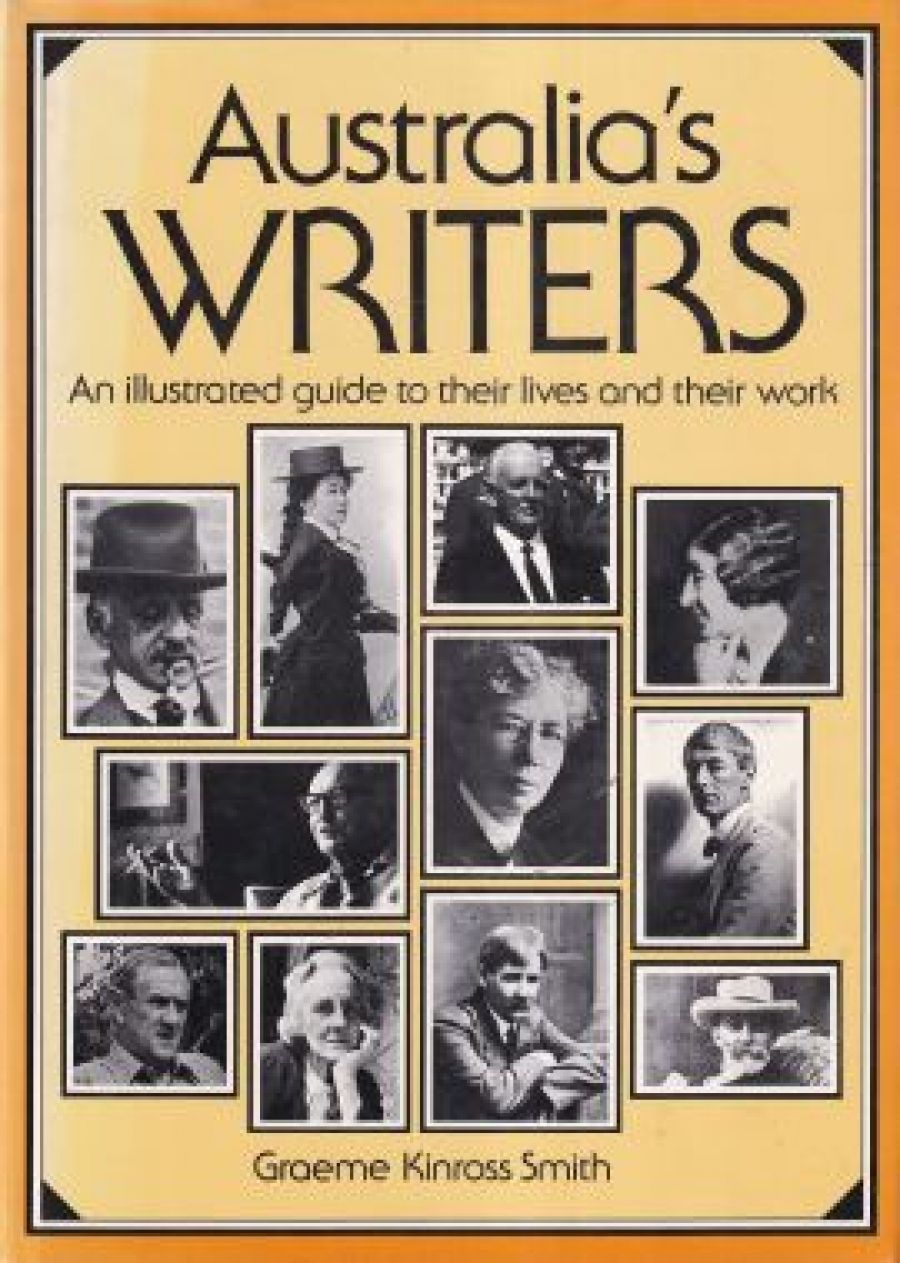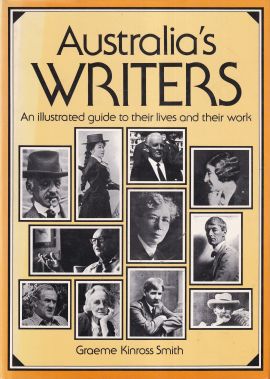
- Free Article: No
- Contents Category: Literary Studies
- Review Article: Yes
- Online Only: No
- Custom Highlight Text:
Normally, Australia’s Writers could be expected to attract the special attention of critics. However, by sensible use of his preface and the quality of his book’s contents, Graeme Kinross Smith has minimised the possibility of adverse comment. Carefully, he sets out the guidelines adopted for the fiftyfour essays that range from two to ten pages each, starting with Captain Arthur Phillip and closing with Rosemary Dobson. Stressing ‘the distinctive and fascinating’ tradition of Australian literature and the book’s purpose in giving an insight into that tradition, Graeme Kinross Smith writes:
- Book 1 Title: Australian Writers
- Book 1 Subtitle: An illustrated guide to their lives and work
- Book 1 Biblio: Nelson, $25 pb, 342 pp
- Book 1 Cover Small (400 x 600):

- Book 1 Cover (800 x 1200):

Having established this viewpoint, Kinross Smith then deals with what could be the controversial aspects of Australia’s Writers, or at least, an interesting subject for discussion:
It is clear no two authors of a work of this nature would arrive at the same list of writers for inclusion. That point is swayed by many considerations. It has to begin from a working definition of the term ‘Australian Writer’ – in this book taken to imply someone whose work is clearly recognised for its illumination of Australia and Australians. ‘International’ writers such as Jon Cleary and Morris West are therefore not included. Only writers who have furthered the development of Australian literature in the more serious sense are considered and thus several ‘popular’ or semi-popular writers of considerable fame have omitted. Then there is the quality of the writer’s work and whether it lasts; of how representative a writer he or she is of the period in which he writes; or perhaps of what unique contribution his work makes to the general stream of Australian writing (Louis Stone’s close studies of the Sydney larrikin ‘pushes’ for example; or the depiction of Australians at war in the works of Leonard Mann and T. A. G. Hungerford). There follow a hundred checks and balances before the list sits comfortably. Even then it remains subjective, although carefully considered.
Assessing Australia’s Writers as a whole, it would be churlish to interpret this as a ‘like it or lump it’ attitude, particularly in the knowledge that Kinross Smith is writing a book on Australia’s contemporary writers.
At first sight, many of the 300 or so photographs and prints used to illustrate the present work are superfluous but ultimately they prove their worth. Whether old or recent, they achieve Kinross Smith’s stated purposes. The first is that of setting the writers against their own territories, the schools they attended, their homes and the street scenes with which they were so familiar. The second is that of creating a pictorial record of places with strong literary associations before they are further changed or obliterated. Used in conjunction with his profiles and – in the case of the living – taped conversations, Kinross Smith’s technique is effective and, in my opinion, innovative.
It is illustrated in the pages devoted to Frank Dalby Davison, author of Man-Shy and the massive 520,000 word The White Thorntree. In search of background, Kinross Smith visited ‘Folding Hills’, the weatherboard farmhouse about forty kilometres from Melbourne in which Davison lived until he died in 1970.
There he saw the kitchen where Davison grappled with his magnum opus for twenty-two years, and spent some time with Maree, Davison’s widow. There is a touch of poetry when Kinross Smith writes of his meeting with her:
Nowadays, the big jets come silently from behind the Kinglake mountains and float over the Davison farm, steadying back, pulling their sound after them, waiting in stack to land at Tullamarine International Airport thirty kilometres away. Maree spares them a glance as the sun slides down their bullet bodies and turns back to lumping bales of hay, ‘cutting the twine, kicking the bales out, tying the twine around her waist so that the calves will not eat it and die. The cows come threading in across the green hill as they used to do when Frank was alive. His ashes are scattered not thirty metres away in the shade of a tree. Nearby is the burial place of Sheila, the beloved brown and gold Border Collie who dogged his footsteps in the paddocks and oversaw his work on the books. ‘There was always the smell of farm dog to accompany the writing of Thorntree’, says Maree Davison. ‘Sheila used to settle into that kitchen corner at Frank’s elbow as he wrote in the light from the window.’
Maree explained that Davison was not a ‘constant’ writer and said that ‘the sap would usually rise in June, July, August’. Vividly, she described Davison at work:
Once he began novelling as we used to say, he became obsessed. He’d put his foot in the pig bucket; he tramped through some fresh cement he’d only just put down – quite oblivious. The footsteps are still there. While he worked round the farm he’d be thinking how he could handle the next section of the book. And the kitchen floor would fill up with his ‘snowballs’ – he’d write a bad page, tackle it the wrong way, screw it up into a snowball, throw it on the floor to be picked up later and burned in the stove.
Graeme Kinross Smith, Senior Lecturer in Australian Studies and Creative Writing at Deakin University, Melbourne, has produced a first class book that should be of considerable interest and use to academics, students, and general readers.
On this score, the assistance given by the Literature Board of the Australia Council is fully justified.


Comments powered by CComment